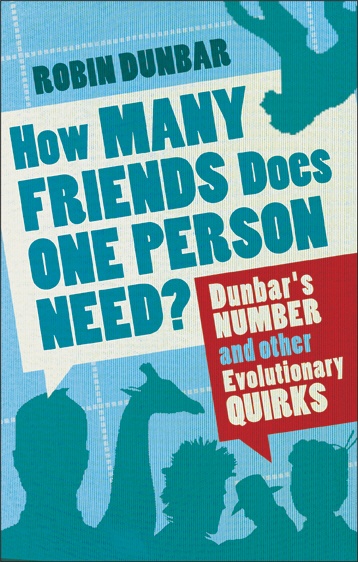
Professor Robin Dunbar is the Director of the Social and Evolutionary Neuroscience Research Group at the University of Oxford and the author of How Many Friends Does One Person Need? Here he shares his thoughts about the arithmetic of friendship.
__________
Noah, it is said, counted the animals into his Ark two by two. Perhaps sensibly in view of the circumstances, he was no doubt thinking in terms of reproduction. Had he been thinking socially, he might instead have counted his animals by threes. That, at least, is the message of several recent studies suggesting that our social networks have a very distinctive structure based on multiples of three.
We all know that we can distinguish friends from acquaintances by how we feel about them. Friends are those we want to spend time with, whereas acquaintances are those whose company is more of a momentary convenience. But it seems that we make even finer judgements than this in real life. What’s perhaps more intriguing is that if you look at the pattern of relationships within the group of 150 that constitutes our social world, a number of circles of intimacy can be detected. The innermost group consists of about three to five people. These seem to constitute the small nucleus of really good friends to whom you go to in times of trouble – for advice, comfort, or perhaps even the loan of money or help. Above this is a slightly larger grouping that typically consists of about ten additional people. And above this is a slightly bigger circle of around thirty more.
The numbers that make up these circles of acquaintanceship seem to have no obvious pattern. But if you consider each successive circle inclusive of all the inner circles, a very clear pattern emerges: they seem to form a sequence that goes up by a factor of three (roughly five, fifteen, fifty and 150). In fact, there are at least two more layers beyond this: there is a grouping at about five hundred and another at about fifteen hundred. And the Greek philosopher Plato even managed to get the next layer out: he identified 5,300 (and I’ll happily allow him the extra three hundred) as the ideal size for a democracy.
We are not sure what all of these successive circles correspond to in real life, or why they should increase in size by a multiple of three, but some correspond to very well known groupings. The grouping of twelve to fifteen, for example, has long been known to social psychologists as the ‘sympathy group’ – all those whose death tomorrow would leave you distraught. Curiously, this is also the typical team size in most team sports, the number of members on a jury, the number of Apostles . . . and the list goes on. The fifty grouping corresponds to the typical overnight camp size among traditional hunter-gatherers like the Australian Aboriginals or the San Bushmen of southernAfrica. And 1,500 is the average size of tribes among hunter-gatherer peoples (usually defined as all the people that speak the same language, or, in the case of very widespread languages, the same dialect).
It seems that each of these circles of acquaintanceship map quite neatly onto two aspects of how we relate to our friends. One is the frequency with which we contact them – at least once a week for the inner circle of five, at least once a month for the circle of fifteen, at least once a year for the 150. But it also seems to coincide with the sense of intimacy we feel: we have the most intense relationships with the inner five, but we have a slightly cooler relationship with the ten additional people that make up the next circle of fifteen. And successively cooler still are our feelings towards the next two layers (those in the circles of fifty and 150).
So it seems as though there is a limit to the number of people we can hold at a particular level of intimacy. There are just so many boxes you can fill in your innermost circle, and if a new person comes into your life, someone has to drop down into the next level to make room for them. Interestingly, kin seem to occur more often than you would expect by chance in each of these successive levels. This isn’t to say that we have to include (or even like!) all our kin, but it does seem that kin get given preference: when all else is equal, blood really is thicker than water and we are more willing to help them out.
[This post is an edited extract from: Robin Dunbar (2010) How Many Friends Does One Person Need: Dunbar’s Number and Other Evolutionary Quirks. London: Faber & Faber. Reproduced with the permission of the publishers.]
__________
Return to: Five Hundred Years of Friendship at the History of Emotions Blog

